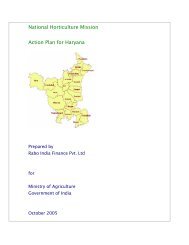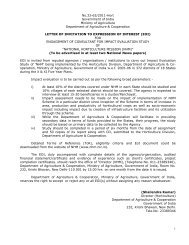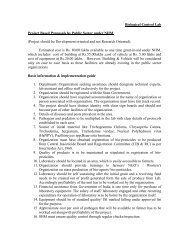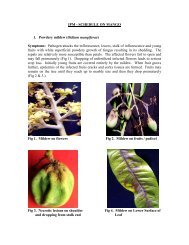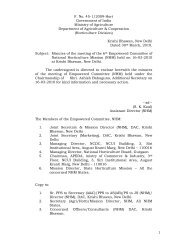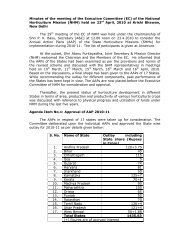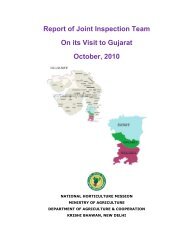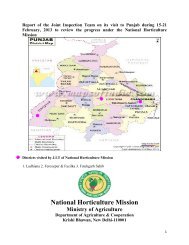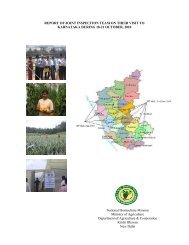Integrated Pest Management Schedule for Vegetables - National ...
Integrated Pest Management Schedule for Vegetables - National ...
Integrated Pest Management Schedule for Vegetables - National ...
Create successful ePaper yourself
Turn your PDF publications into a flip-book with our unique Google optimized e-Paper software.
Spray any systemic insecticides like Acephate 75SP @ lg/l or Dimethoate 30 EC @ 2ml/l.Leaf Eating Caterpillar (Dipahania(=Margaronia) indica Saund)Long shining caterpillars feed on leaves and fruits.Apply neem cake to soil immediately after germination.Spray any contact insecticides like Carbaryl 50 WP @3g/l. Neem or pongamia soap @ 0.75% also effectivelymanages this pest.Soil application of neem cake (once immediatelyafter germination and again at flowering) followedby NSPE @ 4% and neem soap 1% alternately at10-15 days interval.Spray Carbaryl 50 WP @ 3g/l or Indoxacarb 0.5ml/l.Root-knot Nematodes (Meloidogyneincognita)The root-knot nematodes cause root galls from theinitial stages of the crop growth. The larvae feed onthe roots, which show typical galls, and later the entireroot system shows heavy galling. The foliage becomeslight yellowish; the plants become stunted and resultsin flower and fruit drop. In spite of irrigation the plantsappear sick and drooping during daytime.<strong>Management</strong>Seed treatment with bio-pesticide Pseudomonasfluorescens @ 10g/kg seed.Apply Carbofuran 3 G @ 1kg ai/ha at sowing andrepeat after 45 days.Apply 2 tons of FYM enriched with Pochoniachlamydosporia and Paecilomyces lilacinus per acrebe<strong>for</strong>e sowing, along with 100-200 kg of neem orpongamia cake.ONION AND GARLICThrips (Thrips tabaci Lindeman)Thrips feed on a wide range of cultivated plantsand weeds. Some of the principal alternate hostsinclude cabbage, cotton, tomato, cucumber, melons,pumpkins, strawberries and many flowering plants.Thrips are pestiferous in diverse ways. They causedirect damage to leaves and bulbs, aggravate fungaldiseases and even vector virus.Thrip damages onionDamage of bulb leavesThrips hide deep inside flowersThrip damageduring bulb intender leavesCongregationof thripsdevelopment<strong>Management</strong>Monitoring: Sticky traps are commonly used <strong>for</strong>detecting thrips population. Various colours werefound attracting different species of thrips in variousgeographical areas; widely used ones are yellow andbright blue traps.CulturalGood crop management practices can be readilymanipulated to the disadvantage of thrips.Field sanitation techniques such as removingalternate weed host on bunds and destruction ofculls of onion and garlic are helpful to some extentin bringing down thrips population.Avoid successive planting of onion and garlic orother preferred host. There<strong>for</strong>e, planting in upwinddirection could be helpful in escaping infestationfrom old planting to some extent in the initialstages.Planting DateBy making adjustments in transplanting dates, onionscan be made tolerant to early thrips attack andsatisfactory yields can be obtained with minimumchemical intervention.18 <strong>Integrated</strong> <strong>Pest</strong> <strong>Management</strong> <strong>Schedule</strong> <strong>for</strong> <strong>Vegetables</strong>



